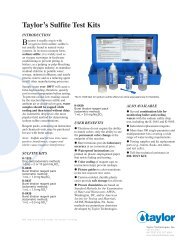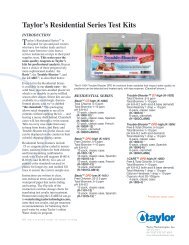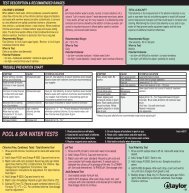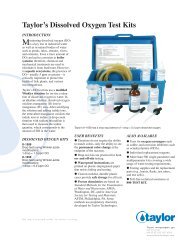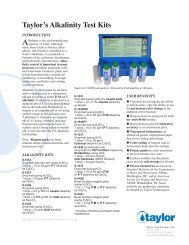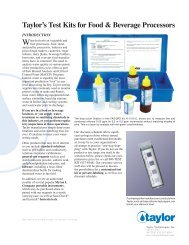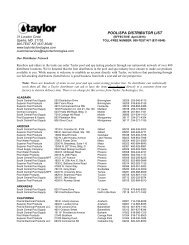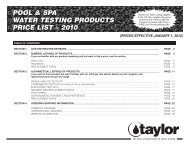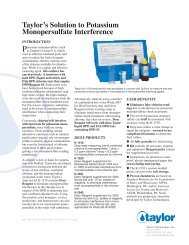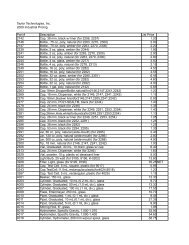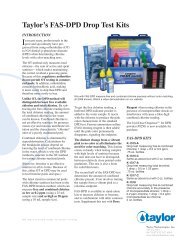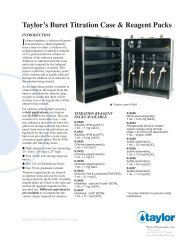Taylor's QAC & Polyquat Test Kits - Taylor Technologies
Taylor's QAC & Polyquat Test Kits - Taylor Technologies
Taylor's QAC & Polyquat Test Kits - Taylor Technologies
Create successful ePaper yourself
Turn your PDF publications into a flip-book with our unique Google optimized e-Paper software.
<strong>Taylor</strong>’s <strong>QAC</strong> & <strong>Polyquat</strong> <strong>Test</strong> <strong>Kits</strong>INTRODUCTIONQuaternary ammonium compounds,often referred to as “quats” andabbreviated as <strong>QAC</strong>, and theirstructurally longer cousins the polyquatsare nonoxidizing biocides. In commercialand industrial water treatmentprograms they are widely used tocontrol algae, bacteria, and fungi inopen recirculating water systems(e.g., cooling towers and evaporativecondensers). They interfere with cellmembrane function, which eventuallycauses the organism to die. Thesesurface-active chemicals may be usedin combination with other microbialcontrol agents, such as chlorine.Determination is based upon directneutralization of the <strong>QAC</strong> or polyquat.<strong>QAC</strong> & POLYQUAT KITSK-1582Drop test for high <strong>QAC</strong> & polyquatlevels (using direct neutralization);1 drop = 10 or 25 ppm <strong>QAC</strong>,1 drop = 3.5 or 9 ppm polyquatK-9065Drop test for low <strong>QAC</strong> & polyquatlevels (using direct neutralization);1 drop = 1.25 ppm <strong>QAC</strong>,1 drop = 0.5 ppm polyquatUSER BENEFITS•Titrations do not require the abilityto match colors, only the ability to seethe permanent color change at the•endpoint of the reaction.These test kits are practical for both•on- and off-site testing.<strong>Test</strong> kits come complete with allnecessary reagents and equipment.The K-1582 drop test for determining quaternary ammonium compounds is valued by HVACcooling water service and control personnel.•Waterproof instructions areprinted on plastic-impregnated paper•that resists fading and tearing.Color coding of reagent caps to•instructions helps prevent mishaps.Picture guides to color transitions•in the test reassure new users.Custom-molded, durable plastic•cases provide safe storage for tests.Proven chemistries are based onStandard Methods for the Examinationof Water and Wastewater, APHA,Washington, DC, and/or AmericanSociety for <strong>Test</strong>ing and Materials,ASTM, Philadelphia, PA. Somemethods use proprietary chemistrydeveloped by <strong>Taylor</strong> <strong>Technologies</strong>.ALSO AVAILABLE<strong>Test</strong>s for oxidizing biocides.•Individual replacement reagents.More than 500 single-parameter andmultiparameter kits covering a wide•range of water-testing requirements.<strong>Test</strong>ing supplies and kit replacementparts (e.g., burets, flasks, test tubes,•and test cells).Toll-free technical assistance at800-TEST KIT.
REPRESENTATIVE TEST PROCEDUREReproduced from K-1582 instruction:DROP TESTHIGH <strong>QAC</strong>/HIGH POLYQUAT (1 drop = 3.5 or 9 ppm polyquat, 1 drop = 10 or 25 ppm <strong>QAC</strong>)COMPONENTS:1 x 5256 Instruction1 x 9012 Pipet, Calibrated 0.5 & 1.0 mL, plastic w/brown cap1 x 9198BR Sample Tubes, Graduated, 25 mL, plastic w/cap and brown dot1 x R-0638BR-C Phenolphthalein Indicator (brown cap), 2 oz, DB1 x R-0736BR-C Sulfuric Acid .6N (brown cap), 2 oz, DB1 x R-0881-A Toluidine Blue O Indicator, .75 oz, DB1 x R-0884-C <strong>QAC</strong> Titrating Solution, 2 oz, DB1 x R-0950-C Complexing Reagent, 2 ozTO ORDER REPLACEMENT PARTS AND REAGENTS CALL TOLL-FREE800-TEST KIT (800-837-8548).PROCEDURE:CAREFULLY READ AND FOLLOW PRECAUTIONS ON REAGENT LABELS.KEEP REAGENTS AWAY FROM CHILDREN.For 1 drop = 10 ppm <strong>QAC</strong> or 3.5 ppm polyquatNOTE: Run a blank using water containing no <strong>QAC</strong> or polyquat. Record drops ofR-0884 <strong>QAC</strong> Titrating Solution used.1. Rinse and fill 25 mL sample tube (#9198BR) to 25 mL mark with water to betested (Fig. 1).2. Using a 1.0 mL pipet (#9012), add 1.0 mL R-0950 Complexing Reagent. Swirl tomix.NOTE: If sample water contains a hardness concentration above 500 ppm, add2.0 mL (2 x 1.0 mL) R-0950 Complexing Reagent.3. Add 1 drop R-0638BR Phenolphthalein Indicator. Swirl to mix. If colorless,proceed to Step 4. If pink (Fig. 2), add R-0736BR Sulfuric Acid .6N dropwise,swirling after each drop, until color changes from pink to colorless.4. Add 3 drops R-0881 Toluidine Blue O Indicator. Swirl to mix. Sample should belight blue (Fig. 3).5. Add R-0884 <strong>QAC</strong> Titrating Solution dropwise, swirling and counting after eachdrop, until color changes from light blue to violet-pink (Fig. 4). Always hold bottlein vertical position.NOTE: Further addition of R-0884 <strong>QAC</strong> Titrating Solution should produce no colorchange.6. Subtract drops of R-0884 <strong>QAC</strong> Titrating Solution used in blank from drops used insample (Step 5). Multiply by 10. Record as parts per million (ppm) <strong>QAC</strong> as n-alkyl(60%C 14 , 30% C 16 , 5% C 12 , 5% C 18 ) dimethylbenzylammonium chloride/n-alkyl(68%C 12 , 32% C 14 )dimethylethylbenzylammonium chloride. For results as polyquat,multiply by 3.5. Record as ppm polyquat as poly[oxyethylene(dimethyliminio)ethylene(dimethyliminio)ethylene dichloride].NOTE: Equivalences for quaternary ammonium compounds and polyquats otherthan those listed must be determined by titration with a known standard.For 1 drop = 25 ppm <strong>QAC</strong> or 9 ppm polyquatNOTE: Run a blank using water containing no <strong>QAC</strong> or polyquat. Record drops ofR-0884 <strong>QAC</strong> Titrating Solution used.1. Rinse and fill 25 mL sample tube (#9198BR) to 10 mL mark with water to betested (Fig. 1).2. Using a 1.0 mL pipet (#9012), add 0.5 mL R-0950 Complexing Reagent. Swirl tomix.NOTE: If sample water contains a hardness concentration above 500 ppm, add1.0 mL R-0950 Complexing Reagent.(OVER)Fig. 1Fig. 2Fig. 3Instr. #5256DROP TESTHIGH <strong>QAC</strong>/HIGH POLYQUAT (1 drop = 3.5 or 9 ppm polyquat, 1 drop = 10 or 25 ppm <strong>QAC</strong>)3. Add 1 drop R-0638BR Phenolphthalein Indicator. Swirl to mix. If colorless, proceedto Step 4. If pink (Fig. 2), add R-0736BR Sulfuric Acid .6N dropwise, swirling aftereach drop, until color changes from pink to colorless.4. Add 1 drop R-0881 Toluidine Blue O Indicator. Swirl to mix. Sample should belight blue (Fig. 3).5. Add R-0884 <strong>QAC</strong> Titrating Solution dropwise, swirling and counting after eachdrop, until color changes from light blue to violet-pink (Fig. 4). Always hold bottlein vertical position.NOTE: Further addition of R-0884 <strong>QAC</strong> Titrating Solution should produce no colorchange.6. Subtract drops of R-0884 <strong>QAC</strong> Titrating Solution used in blank from drops usedin sample (Step 5). Multiply by 25. Record as parts per million (ppm) <strong>QAC</strong> asn-alkyl(60% C 14 , 30% C 16 , 5% C 12 , 5% C 18 )dimethylbenzylammonium chloride/n-alkyl(68% C 12 , 32% C 14 )dimethylethylbenzylammonium chloride. For resultsas polyquat, multiply by 9. Record as ppm polyquat as poly[oxyethylene(dimethyliminio) ethylene(dimethyliminio)ethylene dichloride].NOTE: Equivalences for quaternary ammonium compounds and polyquats otherthan those listed must be determined by titration with a known standard.Fig. 4Instr. #525631 Loveton Circle, Sparks, MD 21152 U.S.A.800-TEST KIT (837-8548) • 410-472-4340 3/09rev. 011910




